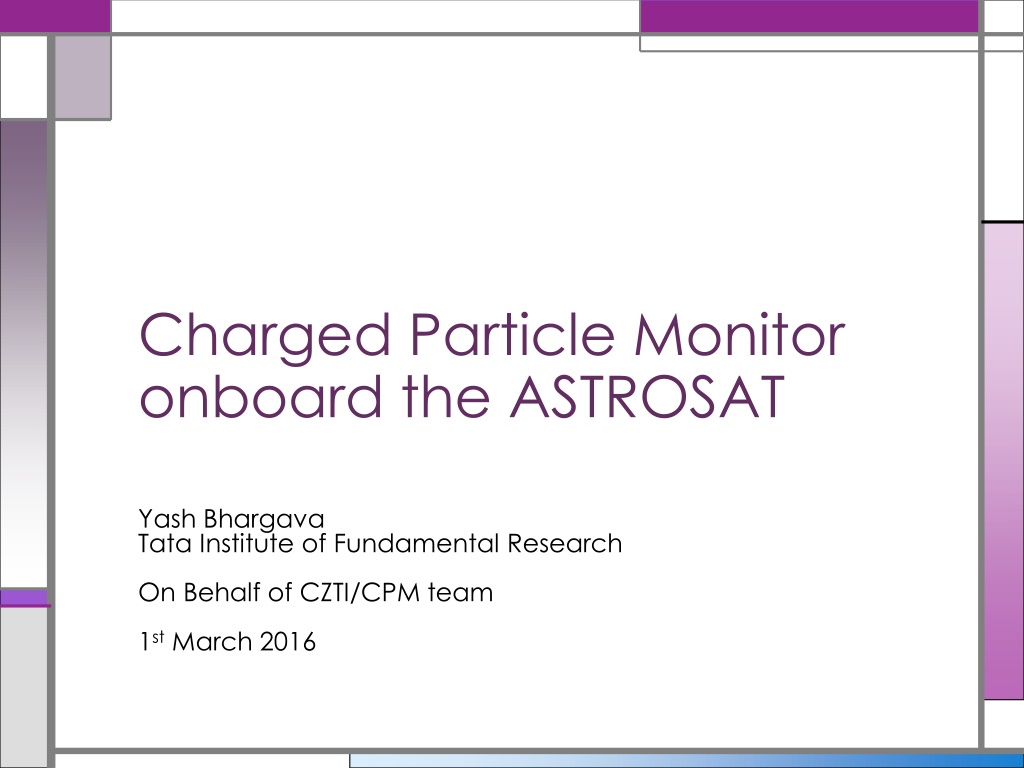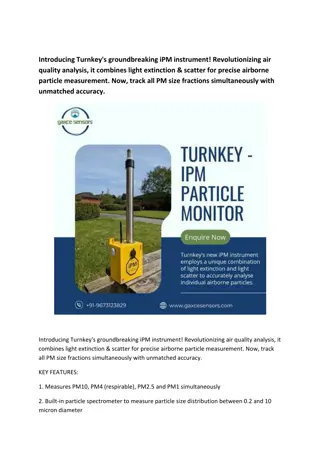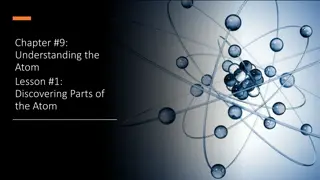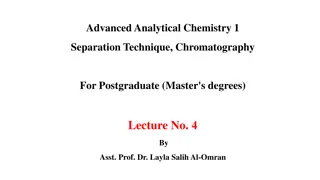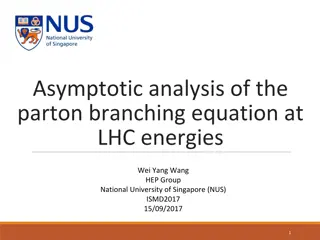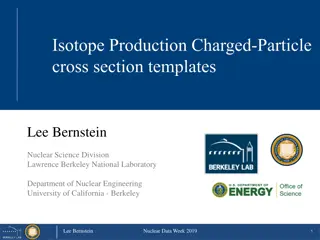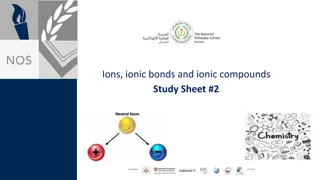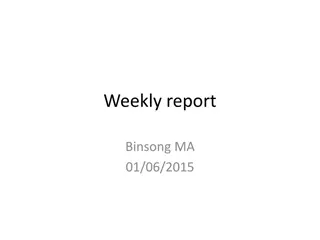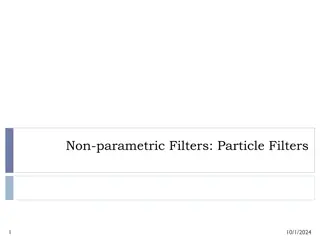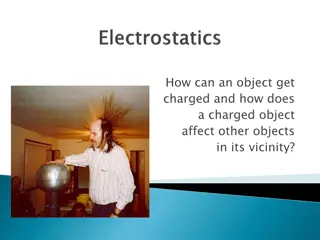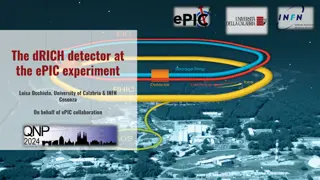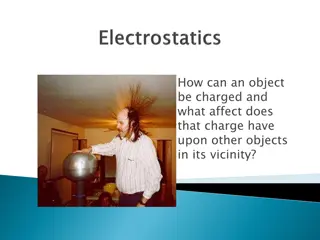Charged Particle Monitor onboard the ASTROSAT by Yash Bhargava - Research Overview
A detailed research project conducted by Yash Bhargava from the Tata Institute of Fundamental Research on the Charged Particle Monitor onboard the ASTROSAT, focusing on monitoring charged particles, South Atlantic Anomaly, solar flares, detector effects, and calibration techniques. The study includes design aspects, logic implementation, ground calibration, spectral fitting methods, and testing with radioactive sources and protons in various energy ranges. Additionally, stability tests were performed to evaluate peak position and stability under different conditions.
- ASTROSAT
- Charged Particle Monitor
- Yash Bhargava
- Tata Institute of Fundamental Research
- Spectral Fitting
Download Presentation

Please find below an Image/Link to download the presentation.
The content on the website is provided AS IS for your information and personal use only. It may not be sold, licensed, or shared on other websites without obtaining consent from the author. Download presentation by click this link. If you encounter any issues during the download, it is possible that the publisher has removed the file from their server.
E N D
Presentation Transcript
Charged Particle Monitor onboard the ASTROSAT Yash Bhargava Tata Institute of Fundamental Research On Behalf of CZTI/CPM team 1stMarch 2016
Motivation for CPM South Atlantic Anomaly Drifting Solar flares Effect of Charged particles on the detector Yash Bhargava - Charged Particle Monitor onboard the ASTROSAT 1st March 2016 2
CPM design Scintillating crystal detector CsI(Tl) Light detector Photodiode with CSPA Cost Effective No gain change Yash Bhargava - Charged Particle Monitor onboard the ASTROSAT 1st March 2016 3
CPM logic Yash Bhargava - Charged Particle Monitor onboard the ASTROSAT 1st March 2016 4
Ground Calibration Yash Bhargava - Charged Particle Monitor onboard the ASTROSAT 1st March 2016 5
Spectral Fitting Absence of direct energy information Multi-Channel Analyser used in engineering model Integral spectrum using LLD Gaussian fitting to determine the peak position Yash Bhargava - Charged Particle Monitor onboard the ASTROSAT 1st March 2016 6
Testing with different sources 180 Radioactive sources Ba133, Cs137 and Eu152 160 y = 0.1206x + 1.556 R = 0.9955 Channel number 140 Detector response 1.20 mV/keV 120 100 80 60 40 Source Energy (in MeV) Peak Channel number 300 500 700 900 1100 1300 1500 Photon Energy (in keV) Ba133 356 43.1 Cs137 662 85.2 Eu152 1112 131 Eu152 1408 173.6 Yash Bhargava - Charged Particle Monitor onboard the ASTROSAT 1st March 2016 7
500 Testing with particles 450 Channel number 400 Tested in BARC-TIFR Pelletron facility 350 300 Protons of energy 15 MeV, 17 MeV and 18 MeV used 250 y = 48.477x - 115.62 R = 0.9994 200 Attenuation observed due to air column, Teflon, Aluminum Mylar 150 5 7 9 11 13 Proton Energy (in MeV) Energy (MeV) Peak channel number Error in energy(MeV) 6.07 177.5 0.7 10.1 378 0.45 11.7 448.7 0.35 Yash Bhargava - Charged Particle Monitor onboard the ASTROSAT 1st March 2016 8
Stability tests Detector exposed to the source for varying time durations Stability in Peak position and PWHM is observed Stability with time 190 185 Peak Channel 180 October 25, 2010 November 30, 2010 175 Linear (October 25, 2010) Linear (November 30, 2010) 170 165 1 10 100 Time Exposed 1000 10000 100000 Yash Bhargava - Charged Particle Monitor onboard the ASTROSAT 1st March 2016 9
Stability with environment Detector tested in Thermo- Vacuum chamber -10oC to 40oC Stable results in 10-30oC Yash Bhargava - Charged Particle Monitor onboard the ASTROSAT 1st March 2016 10
Onboard testing Yash Bhargava - Charged Particle Monitor onboard the ASTROSAT 1st March 2016 11
Switching ON Default values Gating time 5 s Count threshold 3 counts/s Entry trigger criteria - 3 Yash Bhargava - Charged Particle Monitor onboard the ASTROSAT 1st March 2016 12
Contour of SAA Yash Bhargava - Charged Particle Monitor onboard the ASTROSAT 1st March 2016 13
Onboard Stability of CPM Mean and Variance of observed counts binned by square degree interval Clear segregation between SAA and non SAA regions Yash Bhargava - Charged Particle Monitor onboard the ASTROSAT 1st March 2016 14
Products from CPM Monthly contour maps of SAA Average counts in each square degree of Satellite path for ready reference SAA window for Astrosat (in case CPM trigger fails) Currently set at 100oW to 0oE for all possible latitudes Trapezoidal window can be set for more data time Yash Bhargava - Charged Particle Monitor onboard the ASTROSAT 1st March 2016 15
Thank you! Yash Bhargava - Charged Particle Monitor onboard the ASTROSAT 1st March 2016 16
